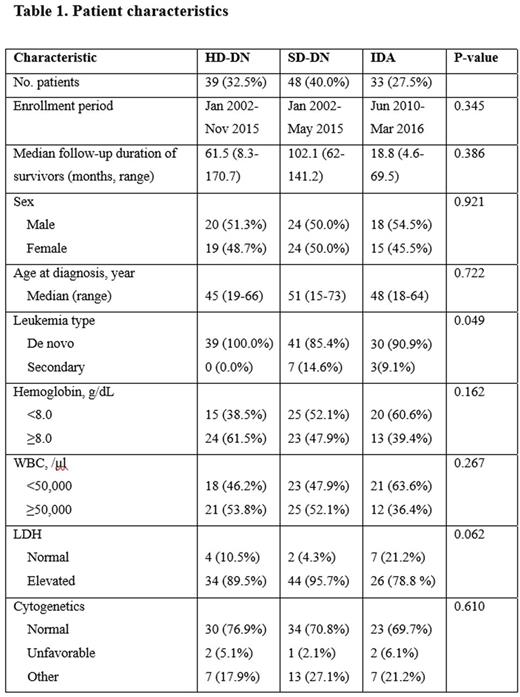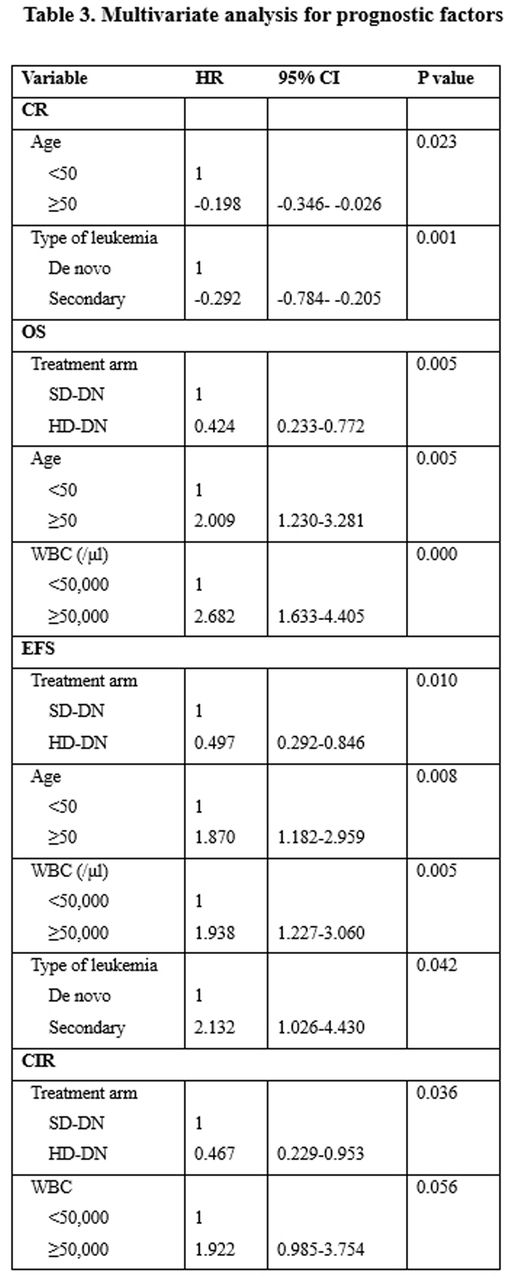Abstract
Background
Patients with FLT3-ITD mutated acute myeloid leukemia (AML) have generally poor survival. Recent update of ECOG trial comparing standard- vs. high-dose daunorubicin showed that daunorubicin dose intensification improved survival in AML with FLT3-ITD mutants (Blood 2016;127:1551). In subgroup analysis of our previous randomized trial, high-dose daunorubicin seemed to be more effective than idarubicin in AML patients with FLT3-ITD mutants (ASH abstract No. 2535, 2015). In this retrospective investigation, we aimed to evaluate the role of daunorubicin dose intensification for induction therapy in AML patients with FLT3-ITD mutants who were treated at a single institute.
Methods
We analyzed data from 120 patients of newly diagnosed FLT3-ITD mutated AML patients who received induction chemotherapy between January 2002 and March 2016. The regimens consisted of high-dose daunorubicin (HD-DN, 90 mg/m2/d x 3d, n=39), standard-dose daunorubicin (SD-DN, 45 mg/m2/d x 3d, n=48), or idarubicin (IDA, 12 mg/m2/d x 3d, n=33) in combination with cytarabine (200 mg/m2/d x 7d). Patients with acute promyelocytic leukemia were not included.
Results
After the first round of induction chemotherapy, 53 patients had persistent leukemia; 50 received the second round of induction chemotherapy consisting of daunorubicin (45 mg/m2/d x 2d) or idarubicin (8 mg/ m2/d x 2d) in addition to cytarabine (200 mg/m2/d x 5d) and 3 received other regimens. A total of 81 patients achieved CR, and the CR rates were 76.9%, 58.3%, and 69.7% in HD-DN, SD-DN, and IDA, respectively (P=0.175). The 4-year cumulative incidence of relapse (CIR) of these 81 patients was 48.8%. With the median follow-up duration of survivors of 59.9 months (range, 4.6-170.7), 4-year overall survival (OS) and event-free survival (EFS) were 57.1%/27.7%/35.7% (P=0.025) and 45.2%/23.9%/36.0% (P=0.042) in HD-DN, SD-DN, and IDA, respectively. HD-DN showed statistically higher OS (hazard ration [HR], 0.424; P=0.005) and EFS (HR, 0.497; P=0.01), and lower CIR (P=0.036) than SD-DN, while OS and EFS differences between HD-DN and IDA were not statistically significant.
Conclusion
Daunorubicin dose intensification for induction therapy seemed to be effective in AML patients with FLT3-ITD mutants. Further studies are needed to investigate whether HD-DN is superior to IDA in this population. Considering high relapse rate, combination strategies of daunorubicin dose intensification and targeted agents such as FLT3 inhibitors should be developed.
No relevant conflicts of interest to declare.
Author notes
Asterisk with author names denotes non-ASH members.




This feature is available to Subscribers Only
Sign In or Create an Account Close Modal